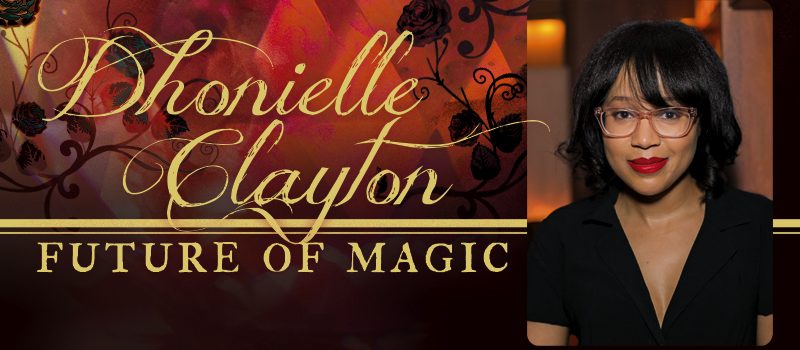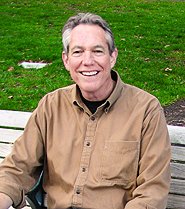Dhonielle Clayton: Future of Magic

Dhonielle Clayton was born May 26, 1983 in Olney MD and grew up “right in the shadows of DC.” Clayton graduated from Wake Forest University in 2005, earned her MA from Hollins University in 2008, and her MFA in creative writing from The New School in 2012. She has worked as a children’s librarian.
Clayton writes SF, fantasy, and contemporary works for children and young adults. Her first fantasy novel The Belles (2018) was a Lodestar Award finalist, and was followed by sequel The Everlasting Rose (2019). Shattered Midnight (2022) is second in the four-book fantasy Mirror series, with each volume written by a different author. Her newest book is The Marvellers, first in a magical school series.
She co-authored three contemporary YA books with Sona Charaipotra: Tiny Pretty Things (2015) and sequel Shiny Broken Pieces (2016), and The Rumor Game (2022); the first was adapted as a television series in 2020. She created the interlinked novel Blackout (2022) with co-authors Tiffany D. Jackson, Angie Thomas, Nic Stone, Ashley Woodfolk, and Nicola Yoon.
Clayton is COO of non-profit We Need Diverse Books, and edited their SFF anthology A Universe of Wishes (2020). She also runs book packager Cake Creative. Since 2019, she’s co-hosted podcast Deadline City with Zoraida Córdova.
Excerpt from the interview:
“I circle around topics that bother me in my work. If I revisit all of my books, they’ve definitely come out of things I’ve always been irritated about throughout my life. Books are where I work out a lot of complicated ideas and big feelings. When I started The Belles series, it was twofold. One, working with the demographic of children I was working with, I saw how beauty politics started to become a thing, and saw Black girls being ostracized. I saw their features being demonized. I wanted to find a way to have conversation about the price we put on our bodies and how some people’s bodies are given more value than others. There’s a thread of that in Shattered Midnight.
“Shattered Midnight is part of a four-book series, and it’s a Disney IP where we’re following two families and a curse that has happened and rippled through the generations. My book is set in 1928 in New Orleans, following a Black girl, who is struggling with big questions: ‘Who am I in this time and place and space and how can I get in control of my magic?’ She’s very ostracized because of the time period, and because of the body that she inhabits, and the things that she’s done. I keep centering Black girls and Black girlhood in my work – my own Black girlhood, and the Black girlhoods of the children that I was in service of in my librarianship in East Harlem NY. I’m working out a little bit of my own girlhood about what happens when certain people are forgotten, overlooked, undervalued, or stereotyped. I want to center them and that sort of struggle. All roads lead back to: What’s happening with Black girls? It’s what I’m mostly interested in and what I mostly write, even in my contemporary fiction. It’s all about Black girls and the stuff they’re dealing with or thinking about.
“I think the biggest challenge is when you write IP for someone else, you’re lending your talent. A lot of writers can talk about that when they’re approached to write for Marvel or Star Wars or anything. There’s a unique balance between leaving behind something of value of yourself and also making sure you’re hitting what the IP owner wants you to hit. What was cool about Shattered Midnight and the collection – the first book is Broken Wish, the second book comes out this year in July, and the fourth and final book comes out next year – is that I had three other dynamic women writing in the world: Julie C. Dao, J.C. Cervantes, and L.L. McKinney. We were sort of in our own little TV writers’ room, if you think of it that way. We were given outlines and then we had to fix them, because oftentimes when you’re writing IP for a corporation that might not have as many BIPOC and marginalized people in it, that IP can have hiccups in it. We were tasked with making sure it was cohesive and making sure the stories flowed together. It was a really fun exercise. The biggest challenge was making sure that I was being both authentic to myself and balancing the needs for the collection, and for the series. My book is supposed to be the love story – an impossible and tragic love story, more of a Romeo and Juliet. That’s not something I normally write, and so I had to dig deep and find my personal anchoring into that world: 1928 New Orleans. I love New Orleans. I went there several times and lived there just briefly to research. It deals with a relationship between a young Black woman and a young white man, so I had to reckon with my own history. I was writing a relationship that would have happened at the same time that my grandmother was born, and thinking about what she was facing at that time. My challenge was to find my entry point, and once I found my entry point and ‘how can this story be personal to me?’ is when it clicked.
“The heart of Shattered Midnight is a story of two families. It’s a story of a broken promise and what happens when we break bonds and what magically can spiral out from that and snowball from that. It’s also a story about coming into one’s own and coming into one’s power, and also what happens when you’ve made a costly mistake. How does one recover from that? How do you reconcile identity? I think a lot of teenagers essentially believe they are the sum of the worst things that they’ve done, and I hope they can have more books that showcase that to be human is to make mistakes, and it’s about what you do after the mistakes that defines your character. Zora, the main character, has made a huge mistake and is trying to figure out who she is after that.
“Zora has the magical gift of music. She got it from her grandparents. She can play any instrument, she can sing, and when she does play instruments or sing, little tiny music notes leave her body and she can manipulate them. Think like honey bees or ladybugs. I wanted the prose to be musical, because she is musical, and we’re in New Orleans, which to me is musical – it is the birthplace of American jazz. That and the delta of Mississippi. I wanted to pay homage to that and to the Black American community where music is the foundation for us, and jazz is a Black musical tradition that changed the world. I wanted to be in that birthplace and to create a world with that texture. I was listening to jazz the entire time, making sure the prose had a musical quality to it.
“If I were able to show you my first draft, you’d be like ‘Ooh! Yikes. What is going on?’ I skeleton and vomit it out, and then craft and clean it. I keep cleaning, and read out loud, and listen for the rhythm and the beats, and think about long sentences and short sentences and mood and pacing. For me, I’m trash for really rich sentences. Some people hate it, and some people love it. I want to be able to smell it, I want to be able to touch it, I want to be able to feel it. Vivid prose is my goal. I want you to be able to imagine yourself there. I am trying to get back to the young reader I was, where I could sit and read and visualize everything. I can remember the books I was reading as young person and falling into them, to the point where I would forget I was under my grandmother’s table for hours. I was in these worlds, and I’m trying to create that experience for other people. I’m a writer who wants to create atmosphere.
“I want books that are big moods, right? I read writers that are just moody as shit in their pages. That’s what I’m trying to be! Holly Black is so moody and I’m chasing her. She’s a very good friend. Her books are dark woods. She lures you in and then the trees start growing around you and you can’t get out. I can’t stop reading her books. That’s what I want to do. They’re atmospheric, and they’re terrifying. I’m trapped in the dark wood of her imagination – and I always want to be there. She’s phenomenal.
“I think my fans are used to me being sort-of all over the place. I write some contemporary fiction, which is blasphemous in the sci-fi fantasy world, so I don’t always claim it. But if someone who loves The Belles follows me into Shattered Midnight, I think they’ll see that The Belles has a whiff of the historical already. I am trash for history and historical things that have a texture of history. In The Belles I was echoing Marie Antoinette’s court, and 18th-century Japan, and a little bit of 18th-century New Orleans. You could find that texture in the references and the metaphors and the iconography, and if you follow me in Shattered Midnight, you’ll see me diving into history and how history and magic intersect, which I’m very interested in. My books are very different, but you can still find the Me. You’re going to get the moodiness, the vividness, the food – I’m always about food – you’re going to get those things that you’re there for. Same with The Marvellers; you’re going to get the mood.
Interview design by Francesca Myman.
Read the full interview in the May 2022 issue of Locus.
 While you are here, please take a moment to support Locus with a one-time or recurring donation. We rely on reader donations to keep the magazine and site going, and would like to keep the site paywall free, but WE NEED YOUR FINANCIAL SUPPORT to continue quality coverage of the science fiction and fantasy field.
While you are here, please take a moment to support Locus with a one-time or recurring donation. We rely on reader donations to keep the magazine and site going, and would like to keep the site paywall free, but WE NEED YOUR FINANCIAL SUPPORT to continue quality coverage of the science fiction and fantasy field.
©Locus Magazine. Copyrighted material may not be republished without permission of LSFF.








